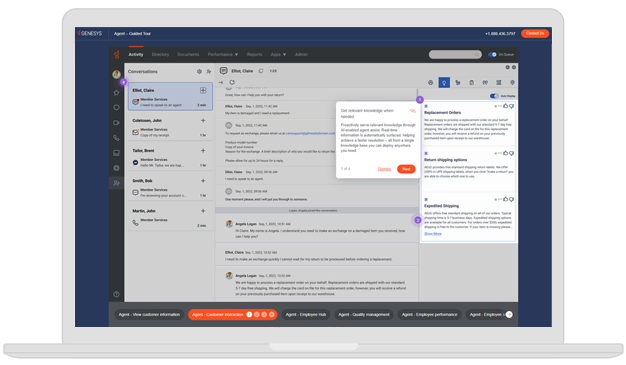Experience orchestration is the process of connecting systems, data and interactions across channels to deliver seamless, personalized customer experiences. It enables organizations to understand intent, predict needs and guide every moment of the customer journey in real time. Unlike automation, it focuses on emotional intelligence and empathy at scale.
“This is where experience orchestration becomes essential — and why it’s emerging as the new strategic platform powered by AI to connect and coordinate all the people and systems of record that go into delivering on your customer experience vision. Experience orchestration is no longer a niche technology. It’s a strategic imperative for CEOs, CIOs and CX leaders alike.”
Olivier Jouve
Chief Product Officer, Genesys
Experience orchestration use cases for enterprises
The most common enterprise-level use cases for experience orchestration include:
- Creating personalized customer journeys
- Enhancing customer support efficiency
- Turning data into predictive engagement
- Coordinating omnichannel experiences
- Empowering employees with contextual intelligence
1. Creating personalized customer journeys
Enterprises use customer experience orchestration to unify data from multiple touchpoints and tailor each interaction. By connecting marketing, sales and service systems, businesses can anticipate needs, recommend next-best actions and deliver consistent experiences that strengthen loyalty and retention.
2. Enhancing customer support efficiency
With customer orchestration, contact centers gain visibility into each customer’s history and context. Agents receive real-time insights about previous interactions, channel preferences and sentiment. This context-driven support reduces handle time and ensures every interaction feels personal — no matter which agent or channel is used.
3. Turning data into predictive engagement
Enterprises apply customer journey orchestration to analyze behavior across websites, apps and communications. AI models detect when a customer is likely to churn, struggle or convert — triggering proactive outreach through chat, voice or email. This data-driven engagement builds trust while increasing conversion rates.
4. Coordinating omnichannel experiences
Experience orchestration bridges siloed systems and ensures conversations flow smoothly across voice, chat, email and social channels. Whether customers begin with a chatbot or escalate to an agent, the journey remains uninterrupted. This consistent, connected experience improves satisfaction and operational efficiency.
5. Empowering employees with contextual intelligence
Beyond customer-facing benefits, experience orchestration supports employees with intelligent routing and context-sharing. Agents and supervisors see the same unified journey map, enabling more informed decisions, better coaching and stronger collaboration between departments.
Elevate customer experience orchestration with Genesys Cloud
Deliver personalized, connected journeys across every interaction with Genesys Cloud™, the AI-Powered Experience Orchestration platform. Built to unify data and automate empathy at scale, it empowers enterprises to transform every moment into a growth opportunity.
See how Genesys Cloud redefines experience orchestration — schedule a demo today.







